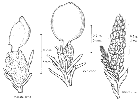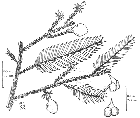Dacrycarpus imbricatus
(Blume) de Laub. 1969
Common names
Var. imbricatus: "Java: djamudju, kihadji, kipuiri, tjemoro (tukung), Tjidadap, S; kadju pakis, tjemara binèh, Md.; SW. Celebes (Bonthain): kayu angin, k. parang; Lesser Sunda Islands: Bali: tarupanda; Sumba: kayu awama, Lairondja, kadju uamang; Lombok: majangmekar; Flores: oh-ru, Ruteng; Timor: haae tuni, W. Timor, Nenas, ai-caqueu fuie, E. Timor, Tetun lang" (de Laubenfels 1988).
Taxonomic notes
Syn: Podocarpus imbricatus Blume 1827; Podocarpus cupressina R.Br. ex Mirbel 1925; Podocarpus javanicus (non Burm.f) Merr. 1921 (de Laubenfels 1988).
Key To The Varieties: (from de Laubenfels (1988))
| 1. Leaves slender (0.4-0.6 mm wide); involucral leaves always spreading. |
 | 2. Leaves imbricate: var. imbricatus (described hereunder) |
 | 2. Leaves spreading: var. patulus |
| 1. Leaves robust (0.6-1 mm wide); involucral leaves sometimes clasping the receptacle. |
 | 3. Leaves spreading: var. robustus |
 | 3. Leaves imbricate: var. curvulus |
Description
Trees up to 50 m tall and 50-70(-200) cm dbh, with straight clear bole of up to 20 m and often a dome-shaped crown. Branches abundant, spreading, the lower ones often pendulous. Fruiting branches slightly quadrangular. Bark red-brown and rugose. Inner bark orange, with brownish resin. Leaves of primary shoots imbricate; leaves of juvenile foliage shoots distichous, nearly linear, (6-)10-17 mm long by 1.2-2.2 mm wide at the centre of a shoot, gradually losing the distichous habit as the tree matures, but shoots with more or less bilaterally flattened leaves distinctly longer in the middle of the shoot almost always present on even the oldest trees. Terminal shoots on young plants often elongated whip-like up to 20 cm. Leaves on older trees eventually becoming mostly scale-like, imbricate, distinctly keeled on the dorsal side, long-triangular, 1-3 by 0.4-0.6 mm. Involucral leaves becoming spreading, acicular, 2.5-4 mm long, rarely to 5 mm. Male cone axillary, 1 cm long. Female cones solitary or grouped in 2 at the tip of twigs, but only one fertile, ripe receptacle red. Seed ovoid, 0.5-0.6 cm long, glossy, red when mature (de Laubenfels 1988, FIPI 1996).
On var. imbricatus: "Male flowers at Tjibodas in Aug.-Sept. Sometimes the stem of full-grown trees produces sprouts at the base" (de Laubenfels 1988).
Distribution and Ecology
N Burma, far S China, Vietnam, Laos, Malaya, Philippines (Luzon, Mindanao), Sumatra, Borneo, Java, Celebes, Moluccas (Morotal, Ceram), Lesser Sunda Islands (Bali-Timor), New Guinea (incl. New Britain and New Ireland), New Hebrides, and Fiji (de Laubenfels 1988, FIPI 1996). Within its range, mean annual temperature is 18.0°C, with an average minimum in the coldest month of 11.7°C, and a mean annual precipitation of 2569 mm (Biffin et al. 2011, Table S5).
Var. imbricatus is confined to Java, the Lesser Sunda Islands (Bali-Timor) and the SW. & C Celebes. It is "[m]ostly scattered and common in primary and secondary rain-forest, not rarely as an emergent, and co-dominant in West Java with Podocarpus neriifolius and Altingia noronhae, on the south slope of Mt Tjeremai volcano characterizing the zone between 2400-2700 m without other co-dominants, a situation not yet explained, in Timor found under more or less seasonal conditions in isolated specimens laden with Usnea [an epiphytic lichen] in grassland after deforestation, mostly between 1000-2500 m, but in Lombok reported as low as 200 m and in Celebes ascending to 3000 m. Probably exterminated at lower elevations in Java by deforestation" (de Laubenfels 1988).
Zone 10 (cold hardiness limit between -1°C and +4.4°C) (Bannister and Neuner 2001).
Remarkable Specimens
No data as of 2023.02.21.
Ethnobotany
Var. imbricatus is a valuable timber tree (de Laubenfels 1988).
Observations
No data as of 2023.02.21.
Remarks
The epithet is Latin, referring to the overlapping foliage found on primary shoots.
Citations
Laubenfels, D. J. de. 1969. A revision of the Malesian and Pacific rainforest conifers, I. Podocarpaceae, in part. Journal of the Arnold Arboretum 50:317-326. Available: Biodiversity Heritage Library, accessed 2021.12.24.
See also
Hiep et al. 2004.
Luu and Thomas 2004 provide a description, range map, conservation status, drawings and photos, and a wealth of additional information.
McKone, Daniel. 1997. Dacrycarpus imbricatus. http://www.mckone.org/dac.html, accessed 2001.12.16, now defunct. This is a page devoted to D. imbricatus in Laos, containing many photographs.
Van Royen 1979.




